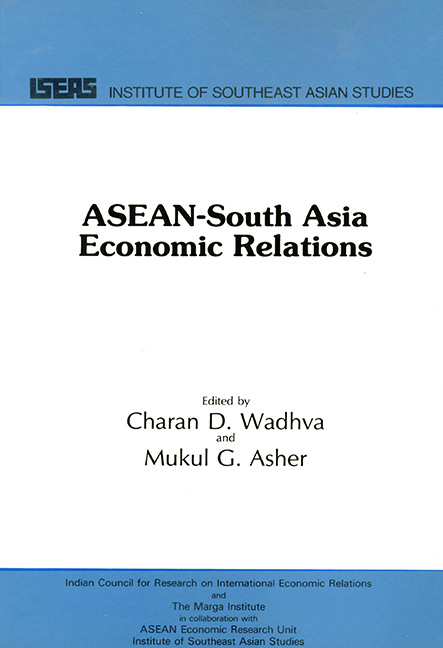Book contents
- Frontmatter
- Contents
- Foreword
- Exchange Rates of ASEAN and South Asian Countries
- An Overview
- PART ONE ASEAN COUNTRY STUDIES
- Economic Relations between Indonesia and South Asia
- Malaysia-South Asia Economic Relations: A Preliminary Study
- Philippine-South Asia Economic Relations
- Economic Relations between Singapore and South Asia
- Economic Relations between Thailand and South Asia
- PART TWO SOUTH ASIA COUNTRY STUDIES
- Postscript
- Appendix SITC Classification at One-, Two-, and Three-digit Levels
- THE EDITORS
Malaysia-South Asia Economic Relations: A Preliminary Study
from PART ONE - ASEAN COUNTRY STUDIES
Published online by Cambridge University Press: 21 October 2015
- Frontmatter
- Contents
- Foreword
- Exchange Rates of ASEAN and South Asian Countries
- An Overview
- PART ONE ASEAN COUNTRY STUDIES
- Economic Relations between Indonesia and South Asia
- Malaysia-South Asia Economic Relations: A Preliminary Study
- Philippine-South Asia Economic Relations
- Economic Relations between Singapore and South Asia
- Economic Relations between Thailand and South Asia
- PART TWO SOUTH ASIA COUNTRY STUDIES
- Postscript
- Appendix SITC Classification at One-, Two-, and Three-digit Levels
- THE EDITORS
Summary
INTRODUCTION
The beginning of Malaysia-South Asia economic relations can be traced historically back to the pre-British and pre-Islamic period. Historical evidence suggests that brisk trade flows had taken place between the Indian and Malay kingdoms. In modern times, this relationship has grown stronger in absolute terms, although it has been overshadowed in relative terms by the emergence of stronger economic links which have dominated the external relations of Malaysia and South Asian countries. An attempt is made in this paper to outline and analyse the extent and pattern of Malaysia's economic relations with the South Asian countries.
MALAYSIA-SOUTH ASIA TRADE
The seventies witnessed increasing two-way trade flows between Malaysia and most of the South Asian countries. Malaysia's exports to and imports from South Asian countries during the period 1970-80 are given in Tables 1 and 2, respectively. Malaysian exports to South Asia as a whole increased from M$37.9 million in 1970 to M$929.5 million in 1980, while Malaysia's imports from South Asia rose from M$78.1 million in 1970 to M$269.1 million in 1980. It is clear that the growth in the trade flows had been very assymetrical, with Malaysia's exports to South Asia growing by 244 per cent and Malaysia's imports from South Asia registering an increase of 25.3 per cent over the decade. In other words, Malaysia's exports to South Asia had grown roughly ten times faster than its imports from South Asia.
Among the South Asian countries, India has almost always been the single most important trading partner of Malaysia. In 1970, India accounted for 50.7 per cent of Malaysia's exports to South Asia and by 1979 its share had increased to 73.3 per cent (see Table 3). India figures even more prominantly in the imports of Malaysia from South Asia: it accounted for 81.9 and 93.9 per cent of Malaysia's imports from South Asia in 1970 and 1979, respectively (see Table 4).
- Type
- Chapter
- Information
- ASEAN-South Asia Economic Relations , pp. 66 - 114Publisher: ISEAS–Yusof Ishak InstitutePrint publication year: 1985

